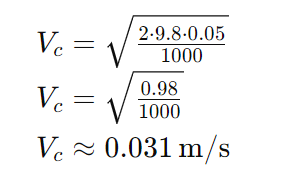Critical Velocity Calculator
Introduction
In the realm of physics, understanding critical velocity is crucial for various applications, especially in fluid dynamics. Whether it’s analyzing the flow of fluids through pipelines or predicting the behavior of objects moving through fluids, critical velocity plays a significant role. To simplify the process of calculating critical velocity, we’ll develop a handy calculator.
How to Use
Using the critical velocity calculator is straightforward. Input the required parameters into their respective fields, and click the “Calculate” button to obtain the critical velocity.
Formula
Critical velocity, often denoted as Vc, is calculated using the formula:

Where:
- g is the acceleration due to gravity (m/s²)
- r is the radius of the pipe (m)
- ρ is the density of the fluid (kg/m³)
Example Solve
Let’s consider an example where the acceleration due to gravity g is 9.8 m/s29.8m/s2, the radius of the pipe r is 0.05 m0.05m, and the density of the fluid ρ is 1000 kg/m31000kg/m3. Plugging these values into the formula, we get:

FAQs
What is critical velocity?
Critical velocity is the minimum velocity required for a fluid to maintain continuous flow in a conduit, such as a pipe, without experiencing turbulence or other flow disruptions.
Why is critical velocity important?
Understanding critical velocity is essential in various engineering applications, such as designing pipelines, determining flow rates, and preventing pipe blockages.
Conclusion
With the critical velocity calculator, you can quickly and accurately determine the critical velocity of a fluid flowing through a conduit. This tool simplifies complex calculations, making it valuable for engineers, researchers, and students alike.
